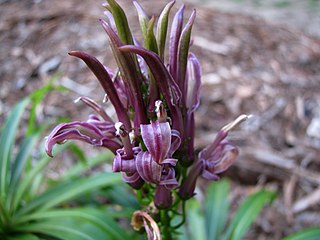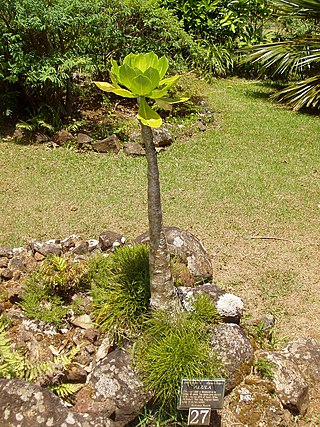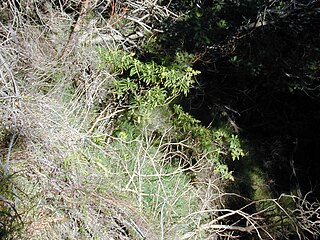
The Hawaiian lobelioids are a group of flowering plants in the bellflower family, Campanulaceae, subfamily Lobelioideae, all of which are endemic to the Hawaiian Islands. This is the largest plant radiation in the Hawaiian Islands, and indeed the largest on any island archipelago, with over 125 species. The six genera involved can be broadly separated based on growth habit: Clermontia are typically branched shrubs or small trees, up to 7 metres (23 ft) tall, with fleshy fruits; Cyanea and Delissea are typically unbranched or branching only at the base, with a cluster of relatively broad leaves at the apex and fleshy fruits; Lobelia and Trematolobelia have long thin leaves down a single, non-woody stem and capsular fruits with wind-dispersed seeds; and the peculiar Brighamia have a short, thick stem with a dense cluster of broad leaves, elongate white flowers, and capsular fruits. The relationships among the genera and sections remains unsettled as of April 2022.

Brighamia insignis, commonly known as ʻŌlulu or Alula in Hawaiian, or colloquially as the vulcan palm or cabbage on a stick, is a species of Hawaiian lobelioid in the bellflower family, Campanulaceae. It is native to the islands of Kauaʻi and Niʻihau, but has been extinct in the wild since at least 2019-2020. This short-lived perennial species is a member of a unique endemic Hawaiian genus with only one other species.

Hibiscadelphus distans is an extremely rare species of flowering plant in the mallow family, Malvaceae, that is endemic to the island of Kauaʻi in Hawaii. It is known as hau kuahiwi in Hawaiian, which means "upland Hibiscus tiliaceus." It is a bush or small tree with heart-shaped leaves and yellow flowers and grows at between 1,000 and 1,800 feet in the remnants of native dry forests. Despite its rarity, it is believed to be the only surviving species in the genus Hibiscadelphus which is only known from Hawaii, the other five species having recently become extinct in the wild, some being known from only a single plant.

The Kauaʻi cave wolf spider, also known to local residents as the blind spider, is only known to occur in a few caves in a lava flow with an area of 10.5 km2 (4.1 sq mi) in the Kōloa–Poʻipū region of Kauaʻi, Hawaiian Islands, and only six populations are known to exist. While their nearest surface-dwelling relatives have large eyes, this species has completely lost its eyes. They reach a body length around 20 mm (0.8 in), and are reddish brown and completely harmless to people. Unlike most wolf spiders, it produces only 15 to 30 eggs per clutch. The female carries the egg sac in her mouthparts until the spiderlings hatch.

The Alakaʻi Wilderness Preserve, popularly known as Alakaʻi Swamp, is a montane wet forest on the Hawaiian island of Kauaʻi. Although the preserve is home to alpine bogs, it is not a true swamp. It is located on a plateau near Mount Waiʻaleʻale, one of the wettest spots on Earth. Due to its unique combination of high elevation and climate, the Alakaʻi Swamp harbors a large number of endangered endemic species that are only found in this area and whose population has been dramatically declining over the last decades. It is designated as a IUCN protected area.

Acacia koaia, known as koaiʻa or koaiʻe in Hawaiian, is a species of acacia that is endemic to Hawaii. It is closely related to koa, and is sometimes considered to be the same species.
Spelaeorchestia koloana, the Kauaʻi cave amphipod or ʻuku noho ana in Hawaiian, is a cave-dwelling crustacean only found on the Hawaiian island of Kauaʻi. It is eyeless and measures 7–10 mm (0.28–0.39 in) long. It is only known from 10 populations, and eats decaying plant matter and other decomposing material.

The ʻakekeʻe or Kaua'i 'akepa is a bird species in the family Fringillidae, where it is placed in the Hawaiian honeycreeper genus Loxops. It is endemic to the island of Kauaʻi where it is found in small numbers in higher elevations. Because of their similar size, shape, and unusual bill, the ʻakekeʻe and the ʻakepa were for some time classified as a single species. This was eventually changed, because of differences in their color, nesting behavior, and calls. The 'akeke'e is extremely threatened and is predicted to face imminent extinction if mosquito control efforts on Kaua'i are not implemented.
Kokia kauaiensis, the Kauai treecotton or Kauaʻi Kokiʻo, is a species of flowering plant in the mallow family, Malvaceae, that is endemic to Kauaʻi, Hawaii.

Lipochaeta, common name nehe, is a genus of flowering plants in the family Asteraceae that is endemic to Hawaii.

Melanthera, is a genus of perennial flowering plants in the family Asteraceae, native to North and South America, as well as Africa, Asia and Oceania, including Hawaiʻi.

Wilkesia hobdyi, the dwarf iliau, is a species of flowering plant in the family Asteraceae that is endemic to the island of Kauaʻi in Hawaii. It was first collected in 1968, and was not formally described until 1971. The number of living plants is estimated at fewer than 300. It is considered Critically Imperiled in global rank which means it is at very high risk of extinction. It has been a federally protected species since 1992. The genus Wilkesia is one of three genera constituting the silversword alliance, a group of highly diverse yet genetically exceedingly closely related species, all thought to be descended from a colonizing ancestor related to the tarweed of North America.

The Makauwahi Cave is the largest limestone cave found in Hawaii. It lies on the south coast of the island of Kauaʻi, in the Māhāʻulepū Valley close to Māhāʻulepū Beach, and is important for its paleoecological and archaeological values. It is reached via a sinkhole and has been described as “…maybe the richest fossil site in the Hawaiian Islands, perhaps in the entire Pacific Island region”.

Dubautia plantaginea is a rare species of flowering plant in the aster family known by the common name plantainleaf dubautia. It is endemic to Hawaii where it is the only member of the silversword alliance that is found on all six of the largest islands. Two of the three subspecies are rare and endangered. Like other Dubautia this plant is called na`ena`e.

Kadua coriacea is a rare species of flowering plant in the coffee family known by the common name kioʻele. It is endemic to Hawaii, where it is known only from the island of Hawaiʻi and one individual remaining on Maui. It is a federally listed endangered species of the United States.
Melanthera kamolensis, known by the common name Maui nehe, is a rare species of flowering plant in the family Asteraceae.

Melanthera micrantha, known by the common name Kauai nehe, is a rare species of flowering plant in the family Asteraceae.

Melanthera tenuifolia is a rare species of flowering plant in the family Asteraceae known by the common names Waianae Range nehe and slender-leaf nehe.
Melanthera venosa is a rare species of flowering plant in the family Asteraceae known by the common name spreading nehe. It is endemic to Hawaii, where it is known only from the island of Hawaii. It is federally listed as an endangered species of the United States.
Melanthera waimeaensis is a rare species of flowering plant in the family Asteraceae known by the common name Waimea Canyon nehe. It is endemic to Hawaii, where it is known only from the island of Kauai. It is federally listed as an endangered species of the United States.


















